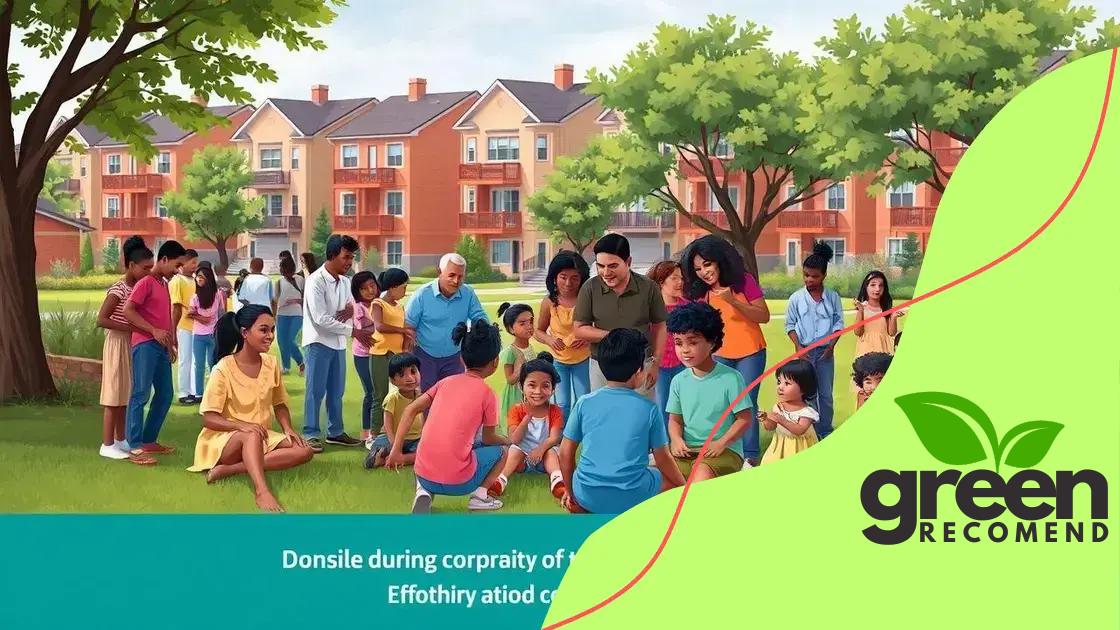Affordable housing benefits for low-income families

Affordable housing provides essential stability and economic opportunity for low-income families, addressing needs through sustainable development, community connections, and innovative solutions amidst challenges such as high demand and limited supply.
Affordable housing benefits for low-income families play a crucial role in improving lives. Have you ever wondered how secure housing can lead to better opportunities? Let’s dive into the ways it can transform communities.
Understanding affordable housing
The topic of affordable housing is essential for low-income families seeking stability. Understanding what affordable housing means and its significance is crucial for fostering better living conditions.
What is Affordable Housing?
Affordable housing refers to housing that is affordable to individuals and families with low to moderate incomes. It represents a significant step towards economic security, allowing households to spend less of their income on housing. This ensures that families can allocate more resources toward necessities like food, healthcare, and education.
Key Benefits of Affordable Housing
- Enhances family stability by providing secure living environments.
- Promotes community development and cohesion.
- Improves access to quality education and employment opportunities.
- Reduces the risk of homelessness.
Moreover, having access to affordable housing can lead to a variety of social improvements. Families are better able to thrive when they don’t have to worry about housing insecurity. Stable homes create stronger communities where children can grow up with consistent support systems.
Investment in affordable housing projects also plays a crucial role in urban development. Cities that prioritize affordable housing initiatives often see a reduction in homelessness rates and an improvement in overall public health indicators. This creates a more vibrant community, fostering economic growth and opportunity.
Challenges Faced
While the benefits are clear, understanding the challenges involved in acquiring affordable housing is just as important. Many families face barriers such as:
- High competition for available units.
- Inadequate funding for housing programs.
- Zoning laws that limit the development of affordable units.
- Stigmatization of affordable housing areas.
These challenges can create obstacles for families in need. Yet, understanding the landscape of affordable housing is a critical first step toward overcoming these barriers and achieving lasting change.
Financial advantages for families
Understanding the financial advantages for families when it comes to affordable housing is essential. For many low-income families, securing stable housing can greatly change their financial outlook.
Lower Monthly Expenses
One of the most significant benefits of affordable housing is the reduction in monthly housing costs. When families pay a lower portion of their income on rent or mortgage, they have more flexibility in managing their budgets. This allows them to focus on:
- Healthcare needs.
- Educational expenses for children.
- Emergency savings.
- Daily living costs.
By allocating less to housing, families can lead healthier lives and ensure they are prepared for unexpected expenses. This financial stability directly impacts their overall well-being and ability to thrive.
Access to Financial Assistance Programs
Families living in affordable housing often have access to various financial assistance programs. These can include:
- Subsidized housing vouchers.
- Grants for first-time homebuyers.
- Tax credits that help reduce rental burdens.
These resources can alleviate the strain of living expenses and help families save for the future. Moreover, participating in such programs can lead to better financial literacy opportunities.
Another financial advantage is increased savings potential. When families spend less on housing, they can save for long-term goals such as education or purchasing a home. This financial security can make a significant difference in their lives, providing hope and improved quality of life.
Community and Economic Growth
Access to affordable housing can also positively impact local economies. When families thrive, they contribute more to their communities. Stable housing enables individuals to invest in local businesses and support community initiatives.
As families become more financially secure, they create a ripple effect of economic growth. This ultimately benefits entire neighborhoods, fostering a sense of community and encouraging further investments.
Community impact of affordable housing

The community impact of affordable housing is profound and far-reaching. When a community invests in affordable housing initiatives, it sets the stage for positive change that benefits everyone.
Fostering Inclusion
Affordable housing plays a crucial role in creating inclusive neighborhoods. It offers families from diverse backgrounds the chance to live in the same area. This rich mixture enhances cultural exchanges and community ties.
Enhancing Local Economy
Communities with affordable housing often see economic growth. When families have stable homes, they tend to:
- Spend more at local businesses.
- Engage in community events.
- Support local schools and services.
This active involvement stimulates the local economy, leading to new business opportunities and job creation. A thriving economy strengthens community bonds and promotes a sense of belonging.
Improved Health Outcomes
Living in stable and affordable housing significantly affects the health of residents. Families experience less stress related to housing instability. Studies show that secure housing leads to:
- Better physical health.
- Improved mental well-being.
- Increased access to healthcare services.
When families have a safe environment, children can focus on their education, and parents can work without the anxiety of housing issues. This cycle contributes to healthier lifestyles for everyone in the community.
Building Stronger Networks
Affordable housing helps create a sense of community. Residents are more likely to build connections with neighbors, forming support networks. These relationships are essential for personal and community well-being.
Furthermore, strong community ties enhance safety and security. When people know their neighbors, they are more engaged in community watch efforts and participate in problem-solving together.
Challenges in accessing affordable housing
The challenges in accessing affordable housing are significant and affect many low-income families. Several barriers prevent families from finding stable and affordable living options.
High Demand and Low Supply
One major challenge is the high demand for affordable units. Many families struggle to find homes that fit their budgets. As a result, they face stiff competition for available housing. When there are not enough affordable options, families may resort to living in overcrowded conditions or unsafe neighborhoods.
Funding and Policy Issues
Another barrier involves funding for affordable housing projects. Many local and federal programs do not provide sufficient resources to build or maintain affordable units. As a result, some areas lack adequate housing options. Additionally, zoning laws can limit the construction of affordable housing developments. These laws may restrict the types of buildings that can be built or where they can be located.
Families may also encounter complex paperwork and long waiting lists when applying for assistance programs. Navigating these processes can be confusing and time-consuming, discouraging families from pursuing options.
Stigmatization and Misconceptions
Stigmatization surrounding affordable housing can also create challenges. Some communities may view affordable housing projects negatively, believing they could lower property values or lead to crime. These misconceptions can result in community opposition, making it difficult to develop needed housing.
Moreover, families may experience fear of discrimination when seeking housing. This fear can prevent them from applying for available units, even when they qualify.
Limited Resources for Support
Accessing affordable housing involves more than just finding a home; it requires support services too. Many families may lack access to resources that can guide them through the process of finding and securing affordable housing. Without proper support, the chances of overcoming these challenges decrease.
Tackling these barriers requires coordinated efforts among governments, community organizations, and private sectors. By understanding and addressing these challenges, society can move toward better solutions for families seeking affordable housing.
Future trends in affordable housing
Examining future trends in affordable housing reveals innovative approaches and solutions. As communities face growing housing challenges, new ideas emerge to meet the needs of low-income families.
Increasing Focus on Sustainability
One trend gaining traction is the emphasis on sustainable and eco-friendly building practices. Developers are starting to prioritize environmentally friendly materials and energy-efficient designs. This not only reduces the carbon footprint but also decreases utility costs for residents.
Smart Housing Technology
Another exciting trend involves the integration of smart home technology. Features like smart thermostats and energy management systems can help families save on energy bills. These technologies enhance living experiences by making homes safer and more efficient.
- Remote monitoring of home systems.
- Energy consumption tracking.
- Automated lighting and security systems.
Families benefit from increased control over their living environment. This technology can lead to significant cost savings over time while promoting a better quality of life.
Community-Centric Developments
Future affordable housing projects are likely to focus on community-centric designs. This means creating spaces that encourage interaction among residents. Features like shared gardens, community centers, and recreational areas foster a sense of belonging.
By cultivating strong connections, these developments not only provide homes but also build vibrant, supportive communities.
Alternative Housing Solutions
Innovative housing solutions, such as micro-housing and co-housing, are also on the rise. Micro-housing units offer affordable living in smaller spaces, making them ideal for single individuals or couples. Co-housing encourages shared living and resources, which can help reduce costs and create tight-knit communities.
These alternatives can significantly enhance the availability of affordable housing options. Addressing the needs of diverse populations is crucial in future planning.
affordable housing is vital for the well-being of families and communities. It creates stability, fosters economic growth, and encourages social connections. The challenges that exist, such as high demand and funding issues, need to be addressed with innovative solutions. As future trends show, focusing on sustainability and community-centric designs can pave the way for better living conditions. Working together, communities can ensure that everyone has access to safe and affordable homes, making a lasting impact on the quality of life.
FAQ – Frequently Asked Questions about Affordable Housing
What is the importance of affordable housing?
Affordable housing is crucial for providing stability and security for low-income families, allowing them to allocate resources toward education, health, and a better quality of life.
What are some challenges in accessing affordable housing?
Challenges include high demand, limited supply, funding issues, and stigmatization of affordable housing developments in certain communities.
How can affordable housing impact the local economy?
By investing in affordable housing, communities can stimulate economic growth through increased consumer spending and job creation, fostering healthier neighborhoods.
What trends are shaping the future of affordable housing?
Future trends include a focus on sustainability, integration of smart technology, community-centric designs, and alternative housing solutions like micro-housing and co-housing.





